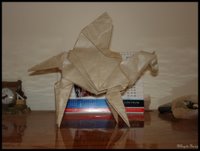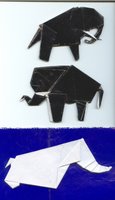
I just finished folding up a peacock and a pair of elephants for my workplace, because the little menagerie that I had there was stolen last week. I had a pair of elephants, a couple of bulls, a sitting bird and a flying parrot. I also had a heart with an arrow passing through it stuck to my monitor. Now only the parrot remains pinned to my cubicle partition.
And in case you haven't guessed by now, and haven't looked at the pictures, I'm talking about Origami animals: animal models made by folding up pieces of paper. Origami is a Japanese art of paper-folding. Traditionally, the best models are those which are made from a single piece of paper, do not require cutting or pasting, and do not require a ruler or any kind of geometrical instrument to make.
It was probably on my sixth birthday that my aunt presented me a book on Origami. It was a Bengali book written by Narayan Sanyal. I was too young to read the complex instructions and make the models at the time. My father came to the rescue, and he read up the first few chapters and taught me how to follow the diagrams. He also made the first few simple models for me. Once I caught up with the thing, there was no turning back. I gradually started making more and more complex models by myself. My grandfather, who was a very creative man and enthusiastic about anything new in general, provided encouragement by buying different coloured papers for me, and even cutting them up into various sized squares so that I could make the models easily. At that time I practised day and night, although it would still take me years to master the most complex models in the book. The Bedouin on horseback shown above is such a model. It is made from a single piece of paper, a piece as large as a full sheet of brown paper.
Then for a few years there was a lull in my Origamic activities, because I had finished the book and had nothing new to make. I did invent a few models of my own, but they were not very good.
 While in college, I suddenly discovered one day that there were a lot of Origami models that could be learnt online. This finding quickly rejuvenated my interest and I learnt several new models like the variety of elephants shown on the left. The fun of Origami is that the symbols are universal and I can follow instructions written in any language. I have managed to keep this hobby alive even after coming into the IT industry. Only, there’s a slight twist to it. These days I usually don’t buy paper but use waste paper instead. It’s quite exciting to hunt for appropriately colored paper among pamphlets, used brochures and magazines.
While in college, I suddenly discovered one day that there were a lot of Origami models that could be learnt online. This finding quickly rejuvenated my interest and I learnt several new models like the variety of elephants shown on the left. The fun of Origami is that the symbols are universal and I can follow instructions written in any language. I have managed to keep this hobby alive even after coming into the IT industry. Only, there’s a slight twist to it. These days I usually don’t buy paper but use waste paper instead. It’s quite exciting to hunt for appropriately colored paper among pamphlets, used brochures and magazines. And the collection on my office desk is ever growing. While others decorate their workspace with little things they bought, I decorate it with waste paper. Unknown people come and ask me about them, and want to learn. I have even taught some colleagues a few simple models. Even the Project Managers ask me about the models when they pass near my desk. That’s quite natural too, because the green coloured flying parrot immediately attracts the attention of any passerby.
 And I intend to improve. I plan to learn more and more models, for I believe that if something is worth doing, it is worth doing well. Right now I’m a bit busy with workload, but I wish to create a few original models of my own in the future. I believe Origami is creativity at its best. Looking at a square sheet of paper, one has to imagine how to make something out of it just by folding. It’s unlike painting or sculpture, where the artist is limited only by his own skill. Here the additional restriction is the paper folding. That’s what makes it more challenging. And I also believe that computers can be made to paint, or even to sculpt in the near future. But they will not be able to do Origami. At most, we can have a robot that folds a piece of paper and creates a model once the instructions are given to it. But original models? Nah! That will remain something that only we humans can ever make.
And I intend to improve. I plan to learn more and more models, for I believe that if something is worth doing, it is worth doing well. Right now I’m a bit busy with workload, but I wish to create a few original models of my own in the future. I believe Origami is creativity at its best. Looking at a square sheet of paper, one has to imagine how to make something out of it just by folding. It’s unlike painting or sculpture, where the artist is limited only by his own skill. Here the additional restriction is the paper folding. That’s what makes it more challenging. And I also believe that computers can be made to paint, or even to sculpt in the near future. But they will not be able to do Origami. At most, we can have a robot that folds a piece of paper and creates a model once the instructions are given to it. But original models? Nah! That will remain something that only we humans can ever make.
I am pretty impressed with the Origami models you made. The bedouin one is really good. We did Orgami in school when we were kids, but this is really taking it several notches up. I am kind if pumped up to try making some models myself. Good post.
ReplyDeletegreat skill.
ReplyDeleteI cannot make more than a plane or rocket of a paper used to throw @ teacher or girls in college.
nice work dude.
Hey, its really cool...My elctromagentics professor used to talk abt this...and was a master at this....never knew such impressive models could be made with origamy theory...!!!! Good skill!! keep it up!! Yeah like Abhijit, my origamic skills are naive, only upto the paper rockets.....:-)
ReplyDeletecan u give me those to test ? :D
ReplyDeletethankfully some things still remained unautomated....thanks for the lovely post...
ReplyDelete@shreemoyee: Thanks. The Bedouin is actually quite tough. As I said, I started with a full sheet of brownpaper and ended up with a model about 20 cm high. Most papers can't survive this kind of folding. Try to search Google for Origami. Since you know the basics, I'm sure you'll be able to make some good models.
ReplyDelete@abhijit: Plane and rocket require skill too, especially making the plane is an art! The ratio of length to breadth, the thickness of the paper and the the wing folds have to be exactly right, or it won't fly. And I'm sure you can make boats too.
@rajesh: Believe me, these are nothing. Japanese Origami master Akira Yoshizawa (1911-2005) could look at your face and fold your portrait out of a sheet of paper.
And like Abhijit, I'm sure you know how to make boats too.
@pradeep soundararajan: Sure! But you'll first have to know the scope...Twisting them up to see if they tear is out of scope. :-P
@monami: Thank YOU for the nice comment. Keep visiting!
cool..like abhijit said..i cant even make a paper plane..!!
ReplyDeleteitz nice to know abt such beautiful nd creative forms of art!!..gr8 goin!!
again..one of d few human expressions still untouchd by research nd development or sm kind of scientific intervention!!!
;)
can you post a links on origami please?
ReplyDelete@kadambari: Thanks!
ReplyDelete@preeti: You can try THIS link...
The peacock looks great! where can i find the folding instructions? I used to do a lot of origami as a child. I have just started a blog on some simple origami designs that i remember doing as a child.
ReplyDelete@origamigirl: Had a brief look at your blog. It looked nice. Unfortunately the folding instructions for the peacock were obtained from a book written in Bengali, and I don't even have that book with me now. I made that from memory.
ReplyDeleteDear Saugata,
ReplyDeleteI'm also a fan of Origami. I have read the book of Narayan Sanyal on this and made some of the models mentioned in his book (The Peacock, bulterrior and the elephant were favorite). This was way back in 1995 after I gone through the class X exams.
Now I am working in an organazation (though they don't use this art, :(( ). I see in the net there are quite a lot of good books on Origami, both on it's history and development and the models. I have downloaded a few of them and going through them. I have visited the site you gave a link to a number of times.
I feel this is quite interesting for all who wants to use their sense of general geometry into a good art. However, in Orkut, I don't see much of good community exchanging these knowledge (in English or Bangla, I mean). If you come across one, please let us know.
@Norbu: Thanks for visiting. The book by Narayan Sanyal that I had did not have the elephant. I learnt it online. There is an Orkut community on origamy and I am a member of that. You can try it out - here is the link. You can also check out this video and this website.
ReplyDeleteHello friend,
ReplyDeleteI am always fascinated by origamy. Your models shows you are a true origamy artist. Have you ever trid peacock made by Akira yosizawa
all The best